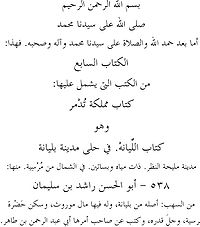Ibn Sa'id al-Maghribi

Abū al-Ḥasan ʿAlī ibn Mūsā ibn Saʿīd al-Maghribī(Arabic:علي بن موسى المغربي بن سعيد) (1213–1286),[1]also known asIbn Saʿīd al-Andalusī,[2]was anArab[3]geographer, historian, poet, and the most important collector of poetry fromal-Andalusin the 12th and 13th centuries.
Biography[edit]
Ibn Said was born atQal'a Benī Sa'īd(modern day Alcalá la Real) nearGranadato a prominent family which was descended from the Companion of the ProphetAmmar ibn Yasir.[4]Many of his family members were literary figures,[5]and grew up inMarrakesh.He subsequently studied inSevilleand stayed inTunis,Alexandria,Cairo,JerusalemandAleppo.At the age of 30, he undertook a pilgrimage toMecca.[6]He was also a close friend of theMuwalladpoet Ibn Mokond Al-Lishboni (ofLisbon). His last years were spent in Tunis, and he died there in 1286.[7]
Writings[edit]
Ibn Said al-Maghribi wrote or compiled 'at least forty works on various branches of knowledge'.[8]
Ibn Said's best known achievement was the completion of the fifteen-volumeal-Mughrib fī ḥulā l-Maghrib('The Extraordinary Book on the Adornments of the West'), which had been started over a century before by Abū Muḥammad al-Ḥijārī (1106–55) at the behest of Ibn Said's great-grandfather ‘Abd al-Malik. Abū Muḥammad al-Ḥijārī completed 6 volumes, ‘Abd al-Malik added to them; two of ‘Abd al-Malik's sons (Ibn Said's grandfather and great uncle) added more; Ibn Said's father worked on it further; and Ibn Said completed it.[9]The work is also known as theKitāb al-Mughrib('book of the Maghrib'), and is midway between an anthology of poetry and a geography, collecting information on the poets of Maghreb organized by geographical origin.[10]
Part of theMughribcirculated separately asRāyāt al-mubarrizīn wa-ghāyāt al-mumayyazīn(Banners of the Champions and the Standards of the Distinguished), which Ibn Said compiled in Cairo, completing it on 21 June 1243 (641 by Islamic dating).[11]It is, in the words ofLouis Crompton,'perhaps the most important' of the various medieval Andalucian poetry anthologies.[12]'His aim in compiling the collection seems to have been to show that poetry produced in the West was as good as anything the East had to offer (and that stuff by Ibn Sa'id and his family was especially good)'.[13]
Ibn Said's works that are probably preserved only fragmentarily, in quotation by others, includeAl-Ṭāli‘ al-Sa‘ı̄d fı̄ Tārı̄kh Banı̄ Sa‘ı̄d,a history of the Banū Sa‘ı̄d.[14]
An example of Ibn Said's own poems, which he included in theRāyāt al-mubarrizīn wa-ghāyāt al-mumayyazīn,is "Black horse with a white chest", with a recent translation beingCola Franzen's translation into English ofGómez's 1930 Spanish translation:[15]
Other works[edit]
- المقتطف من أزاهر الطرف
Notes[edit]
- ^Fernandes, Maria Alice; Abdallah Khawli; Luís Fraga da Silva (2006-12-12)."A viagem de Ibn Ammâr de São Brás a Silves"(PDF)(in Portuguese). Associação Campo Arqueológico de Tavira. Archived fromthe original(PDF)on 2008-11-20.Retrieved2007-12-16.
- ^Arberry, [transl. by] A.J. (2001).Moorish poetry: a translation of the pennants, an anthology compiled in 1243 by the andalusian ibn sa'id(Repr. ed.). Surrey: Curzon.ISBN978-0-7007-1428-5.
- ^Hill, Richard Leslie (1967).A Biographical Dictionary of the Sudan.Psychology Press.ISBN9780714610375.
- ^Ch., Pellat (24 April 2012)."Ibn Saʿīd al-Mag̲h̲ribī".
- ^Rāyāt al-mubarrizīn wa-ghāyāt al-mumayyazīn/The Banners of the Champions: An Anthology of Medieval Arabic Poetry from Andalusia and Beyond,selected and translated by James A. Bellamy and Patricia Owen Steiner (Madison: Hispanic Seminary of Medieval Studies, 1989), p. xxii.
- ^Rāyāt al-mubarrizīn wa-ghāyāt al-mumayyazīn/The Banners of the Champions: An Anthology of Medieval Arabic Poetry from Andalusia and Beyond,selected and translated by James A. Bellamy and Patricia Owen Steiner (Madison: Hispanic Seminary of Medieval Studies, 1989), p. xxii.
- ^Rāyāt al-mubarrizīn wa-ghāyāt al-mumayyazīn/The Banners of the Champions: An Anthology of Medieval Arabic Poetry from Andalusia and Beyond,selected and translated by James A. Bellamy and Patricia Owen Steiner (Madison: Hispanic Seminary of Medieval Studies, 1989), p. xxii.
- ^Rāyāt al-mubarrizīn wa-ghāyāt al-mumayyazīn/The Banners of the Champions: An Anthology of Medieval Arabic Poetry from Andalusia and Beyond,selected and translated by James A. Bellamy and Patricia Owen Steiner (Madison: Hispanic Seminary of Medieval Studies, 1989), p. xxi.
- ^Rāyāt al-mubarrizīn wa-ghāyāt al-mumayyazīn/The Banners of the Champions: An Anthology of Medieval Arabic Poetry from Andalusia and Beyond,selected and translated by James A. Bellamy and Patricia Owen Steiner (Madison: Hispanic Seminary of Medieval Studies, 1989), p. xxi.
- ^"Ibn Said: Book of the Maghrib, 13th Century".Internet Medieval Source Book.Fordham University Center for Medieval Studies.Retrieved2007-12-16.
- ^Rāyāt al-mubarrizīn wa-ghāyāt al-mumayyazīn/The Banners of the Champions: An Anthology of Medieval Arabic Poetry from Andalusia and Beyond,selected and translated by James A. Bellamy and Patricia Owen Steiner (Madison: Hispanic Seminary of Medieval Studies, 1989), p. xxi.
- ^Louis Crompton, 'Male Love and Islamic Law in Arab Spain', inIslamic Homosexualities: Culture, History, and Literature,ed. by Stephen O. Murray and Will Roscoe (New York: New York University Press, 1997), pp. 142-58 (at p. 154).
- ^Robert Irwin,The Penguin Anthology of Classical Arabic Literature(Harmondsworth: Penguin, 1999), p. 301.
- ^Marlé Hammond, 'He said "She said": Narrations of Women's Verse in Classical Arabic Literature. A Case Study: Nazhuūn'sHijā’of Abū Bakr al-Makhzūmī',Middle Eastern Literatures,6:1 (2003), 3-18 (p. 7).doi:10.1080/14752620306884.
- ^Gómez, translated byCola Franzenfrom the Spanish versions of Emilio García (1989).Poems of Arab Andalusia.San Francisco: City Lights Books. p. 69.ISBN978-0-87286-242-5.
External links[edit]
- Geographia, in Arabic
- Excerpt from theBook of the Maghrib,in English
- Excerpt fromKitab al-Bast,in French. [Relations de voyages et textes géographiques arabes, persans et turks relatifs à l’Extrême-Orient du VIIIe au XVIIIe siècles: traduits, revus, et annotés,tr. Gabriel Ferrand (Paris: E. Leroux, 1913), i, 316ff.]
References[edit]
- Ali Ibn Musa Ibn Said al-Magribi und sein Werk al-Gusun al-yaniafi mahasin su ara al-miça as-sabia by M. Kropp, in: Islam (Der) Berlin, 1980, vol. 57, no. 1, pp. 68–96 (2p.)
- His history of the world and Islamic literature: ms. Escorial 1728. edition by Ibrahim al-Ibyari (2 vol.), Cairo 1968
- Arberry, [transl. by] A.J. (2001).Moorish poetry: a translation of the pennants, an anthology compiled in 1243 by the andalusian ibn sa'id(Repr. ed.). Surrey: Curzon.ISBN978-0-7007-1428-5.
- The Banners of the Champions of Ibn Said al-Maghribi,translated by James Bellamy and Patricia Steiner (Madison: Hispanic Seminary of Medieval Studies, 1988)
